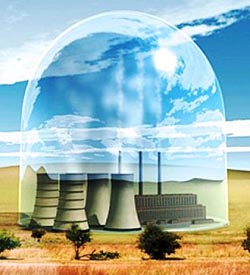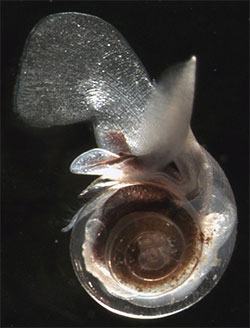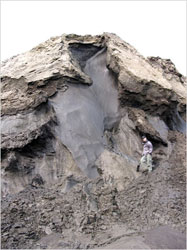

- Devil in the ACES details – fossil fuel industry pork
- Science academies call for Copenhagen to address ocean acidification
- Permafrost’s complex response to rising temperature
- Swiss RE expects a wave of climate litigation
In any legislation that’s nearly 1000 pages long, it’s inevitable that there will be some interesting details. The American Clean Energy and Security Act (ACES) is no exception. Last week, Solve Climate reported on one of those interesting details, namely that ACES has a $50 million per year “self-assessment” that directly benefits the coal and other fossil fuel industries.
According to the article, the direct benefit comes down to the creation of a federal Carbon Storage Research Corporation that is funded by per-kilowatt charges on electric bills instead of a tax on fossil fuel-burning utilities. So not only do the utilities not have to organize themselves, with the overhead costs associated therewith – the federal government does the organizational heavy lifting – they also get to charge their customers a federally-mandated assessment that pays for carbon capture and sequestration (CCS) research instead of having to spend profit dollars to do that research.
Put another way, electricity users pay directly for CCS research and development instead of having utilities peform that research themselves based on market pricing pressure (the usual way to get companies to do R&D in a market economy). The Solve Climate article also points out that the utilities themselves will be the beneficiaries of the Carbon Storage Research Corporation’s federally mandated largess as the Corporation doles out money for research projects.
To recap, fossil fuel-burning utilities a) collect the assessment from their customers directly, b) don’t have to spend the time and money to organize themselves, and c) will be the beneficiaries of the money they collect.
The article points out that the assessment is not technically a tax because a supermajority of utilities who collect the self-assessment have to approve it, but given the advantages the utilities get from this, what motivation would they have to reject the assessment? None that I can see, and none that Dan Greenwood, a professor of corporate finance and law at Hofstra University’s School of Law, can see either. Greenwood is quoted in the article as saying:
This is every industry’s dream – to have the proceeds of a monopoly tax dedicated entirely to your interests. The money doesn’t need to be re-appropriated every year, all of it is dedicated to your industry, and your industry gets to decide on how the money is allocated.
Maybe this lovely piece of fossil fuel pork will be purged by other committees in the House or by the Senate, but I wouldn’t bet on it.
———-
 Science academies call for Copenhagen to address ocean acidification
Science academies call for Copenhagen to address ocean acidification
International negotiators have started the long process of working out a follow-on treat to the Kyoto Protocol that will be finalized in Copenhagen this December. Unfortunately, one of the more serious effects of increased atmospheric carbon dioxide (CO2), ocean acidification, is not presently a driving force behind emissions limits. The Interacademy Panel on International Issues, a body composed of national science academies from around the world, released a statement that aims to raise the profile of ocean acidification among the treaty negotiators.
The IAP Statement on Ocean Acidification says, among other things, that:
If current trends in CO2 emissions continue, model projections suggest that by mid-century CO2 concentrations will be more than double pre-industrial levels and the oceans will be more acidic than they have been for tens of millions of years. The current rate of change is much more rapid than during any event over the last 65 million years.
As a result of the rising acidity and the rate of the increase, the Statement says
[Arctic] waters will be corrosive to Arctic calcifiers such as pteropods, and bivalves such as clams, which play a key role in Arctic food webs.
and
The ocean chemistry changes projected… [are] likely to be too rapid for many species to adapt to. Many coastal animals and groups of phytoplankton and zooplankton may be directly affected with implications for fish, marine mammals and the other groups that depend on them for food.
…
The impacts of these changes on oceanic ecosystems and the services they provide, for example in fisheries, coastal protection, tourism, carbon sequestration and climate regulation, cannot yet be estimated accurately but they are potentially large.
Do you like the taste of salmon or tuna? What happens if increasing CO2 in the atmosphere acidifies the oceans so much that the food chain that feeds salmon and tuna collapses? No more salmon or tuna.
The Statement makes the following recommendations to the pre-Copenhagen negotiators:
- Acknowledge that ocean acidification is a direct and real consequence of increasing atmospheric CO2 concentrations, is already having an effect at current concentrations, and is likely to cause grave harm to important marine ecosystems as CO2 concentrations reach 450 ppm and above;
- Recognise that reducing the build up of CO2 in the atmosphere is the only practicable solution to mitigating ocean acidification;
- Within the context of the UNFCCC negotiations in the run up to Copenhagen 2009, recognise the direct threats posed by increasing atmospheric CO2 emissions to the oceans and therefore society, and take action to mitigate this threat;
- Implement action to reduce global CO2 emissions by at least 50% of 1990 levels by 2050 and continue to reduce them thereafter;
- Reinvigorate action to reduce stressors, such as overfishing and pollution, on marine ecosystems to increase resilience to ocean acidification.
In order to hit the “50% below 1990 by 2050” target, however, some scientists say that global emissions of all greenhouse gases (GHGs) must peak and then start to fall no later than 2015. A similar conclusion was reached by a couple of Tyndall researchers and reported by the Carboholic in September, 2008, where they concluded that “it is difficult to envisage anything other than a planned economic recession being compatible with stabilization at or below 650 ppmv CO2e.”
———-
 Permafrost’s complex response to rising temperature
Permafrost’s complex response to rising temperature
Last week, a new paper was published in the science journal Nature (and reported by the National Science Foundation) that showed for the first time how carbon responds to different amounts of permafrost thaw. Previously, models had predicted that thawing permafrost would result in a release of carbon (in the form of CO2 and/or methane) and methane releases from warming permafrost has been detected previously. But the measurements to date have not shown whether the carbon emitted was greater than carbon absorbed, or how old the carbon emitted was. The new paper not only reported details about both of these things, but also showed that whether permafrost was a net carbon sink or source depended on how long the permafrost had been thawed.
The authors monitored three sites in Alaska where various types of permafrost data has been collected since 1985. Since at least 2004, the authors have been monitoring total carbon moving in and out of the three sites and determining the carbon’s age via by radiocarbon dating. What the authors found is that all three sites – selected for minimal, moderate, and extensive thawing of the permafrost – absorbed carbon during the Arctic summer and emitted carbon during the Arctic winter. As expected, the site with minimal thawing was balanced and the site with extensive melting was a net source of carbon. But the site with moderate thawing was actually a net carbon sink.
Unfortunately, the extensively thawed permafrost emitted much more carbon than it absorbed. So much more, in fact, that all the carbon absorbed while the permafrost was in a “moderately thawed” state was released back into the environment once the permafrost thawed more extensively.
According to the paper, the results of the radiocarbon data confirm that microbial respiration of “old” carbon (carbon prior to nuclear tests in the 40s and 50s) has the potential to emit a significant amount of carbon into the atmosphere.
The authors also attempted to estimate what this could mean for future carbon emissions even as they pointed out that it must “be done with caution.” They estimated that, based on some models, permafrost thaw could release 0.8-1.1 Pg of carbon per year, roughly equal to the estimates of carbon emissions from land use changes such as agriculture, forestry, et al. While the paper says that this emission rate depends on a host of factors that are not presently known, it is consistent with laboratory results.
Thanks to Ubertramp for the NSF link and to Dr. Schuur for the electronic copy of the paper
———-
Swiss RE expects a wave of climate litigation
According to an article in National Underwriter, reinsurance giant Swiss RE expects that a wave of lawsuits relating to climate change is going to hit in the next few years and that it will be similar to the mountain of lawsuits companies faced due to asbestos.
The Zurich-based firm, in an examination of the consequences of globalization of class actions on insurers, said, “We expect, however, that climate change-related liability will develop more quickly than asbestos-related claims and believe the frequency and sustainability of climate change-related litigation could become a significant issue within the next couple of years…”
The company advised, “Given the potential implications of this shift for the insurance industry, developments need to be monitored closely.”
If SwissRE is correct, then we can expect lawsuits against utilities and oil companies. Imagine, for a moment, if the entire population of New Orleans brought suit against Peabody, Arch Coal, and ExxonMobil as a class action for their part emitting CO2 that “created” Hurricane Katrina, or all the families who lost family members in Katrina charged the companies with wrongful death lawsuits. Add into the equation the legal precedent set in the UK by the Greenpeace ruling that released six activists because they stopped climate damage and we have the potential for a horrendous amount of litigation.
Even I’m not thrilled by the sound of that, and I’m someone who wouldn’t cry a single tear if Peabody et al went out of business tomorrow.
According to the National Underwriter article, the SwissRE report warned that “coercive settlements” could be come a significant problem and suggested that “consideration should be given to alternative dispute resolution schemes.”
Image credits:
Engineeringnews.co.za
pmel.noaa.gov
David Froese, University of Alberta, via New York Times



* The persistence of coral reefs through geologic time-when temperatures were as much as 10̊-15̊C warmer than at present, and atmospheric CO2 concentrations were two to seven times higher than they are currently-provides substantive evidence that these marine entities can successfully adapt to a dramatically changing global environment.
* The 18- to 59-cm warming-induced sea-level rise that is predicted for the coming century by the IPCC falls well within the range (2 to 6 mm per year) of typical coral vertical extension rates, which exhibited a modal value of 7 to 8 mm per year during the Holocene and can be more than double that value in certain branching corals. Rising sea levels should therefore present no difficulties for coral reefs.
* The rising CO2 content of the atmosphere may induce very small changes in the well-buffered ocean chemistry (pH) that could slightly reduce coral calcification rates; but potential positive effects of hydrospheric CO2 enrichment may more than compensate for this modest negative phenomenon. Real-world observations indicate that elevated CO2 and elevated temperatures are having a positive effect on most corals.
http://www.nipccreport.org/chapter8.html
One has to admire the ability of the Capitol Crusaders to screw over their constituents for the sake of special interests while making the whole thing seem like they’re helping the nation/planet/people. How thankful i should be that i get to pay for the R&D on a technology that is unproven and expensive so that it won’t affect the bottom line of the companies that will benefit directly from the technology.
Boy, i heart my congressional representation almost as i heart trolls like Judy.
Judy, Judy, Judy…
First, the IPCC sea level rise estimates were out of date before they were even published. And suggesting that the NIPCC document is accurate regarding climate disruption is only slightly better than claiming that the Satanic Bible is accurate regarding the teachings of Jesus – there’s just enough facts to make it look reasonable, but the inaccuracies, lies, and manipulations far outweigh the scattered facts.
So here’s some real numbers on sea level rise that are more recent than the IPCC AR4 estimates. First, satellite altimitry shows an increase of 3.2 mm +/- 0.4mm per year, which works out to about 30 cm by 2100 This is within the range predicted by the IPCC. Except that all models anticipate an increase in the rate of sea level rise, and there’s new data about ice melt that wasn’t included in the IPCC models. Updated models that include Greenland and West Antarctic melting boost that to between 0.7 and 1.6 m (based on one paper) and another researcher finds that 50 cm is probably the minimum level we’ll observe by 2100.
Ultimately, though, whether corals will survive sea level rise or ocean acidification depends on how much the oceans change and how quickly. After all, coral can only grow towards the surface so quickly, and while coral can certainly adapt to match new environments, adaptation takes time. The last time that the oceans acidified this fast was the end of the Cretaceous period, and it was marked by a mass extinction where 30% of identified marine species went extinct. That’s not exactly a change we want to emulate.
Of far greater concern than corals in particular is the ocean food chain in general, because while acidification will probably result in more oceanic dead zones as the amount of CO2 goes up and the amount of oxygen falls, if you kill off the plankton and pteropods that use carbonate to make their shells, then you kill off the food supply for the vast majority of higher organisms (like mollusks, fish, and even marine mammals). Of course, something will step in to take the place of the clams, salmon, and humpback whales – I hear jellyfish are doing great these days.
Something tells me I’d rather eat a salmon than a jellyfish, though.
I hadn’t heard about that Greenpeace ruling before. The class-action suits sound promising.